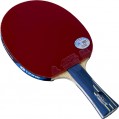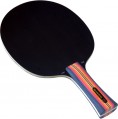Product type
— Racket. This type includes classic table tennis rackets, supplied fully assembled and ready to play out of the box. They are sold one at a time and are not equipped with additional equipment such as a net or balls (however, they can be supplemented with cases, see below). Buying a ready-made racket is often more convenient and cheaper than assembling sports equipment yourself. This is especially true for novice athletes and amateurs, but for professional use, this option is considered less suitable than a self-assembled racket. However, rackets of all classes (see below) and price categories are available today in ready-made form.
—
Base. The base is the part of the racket that includes the handle and the rigid plate on which the pads are attached. Actually, to turn the base into a full-fledged racket, you need to install pads on it. This option is not very convenient for beginners and intermediate-level players, however, professionals often prefer to choose the combination of base and pads themselves, not trusting the selection and assembly of sports equipment manufacturers. Therefore, models of this type, as a rule, belong to the top class, use advanced materials and are expensive - to the point that some “bare” bases are more expensive than ready-made rackets with similar base characteristics.
- Kit. Kits include sets that include, in addition to a finished racket (see above), also additional sports equipment - te
...nnis balls, and sometimes a net. In addition, there can also be several rackets; See below for details on the items included. The convenience of this option is obvious: by purchasing a kit, you can immediately acquire everything you need for a match (except perhaps the table). Most of these kits are made with beginners in mind, but there are exceptions - some kits even reach 5 stars (see “Class”).Number of base layers
The number of layers that make up the base of the racket. The number of layers affects the degree of rigidity and elasticity of the base and, accordingly, the characteristics of the rebound of the ball. However, this moment is irrelevant for the simple reason that the materials used (see above), the presence of inserts, build quality, sponge thickness (see below), etc. also affect the mentioned characteristics. And given that modern table tennis rackets are very diverse (for example, wooden models can use different types of wood), the number of layers is today a reference parameter, which in itself does not affect the practical characteristics of a particular model.
Sponge thickness
The sponge is the bottom layer of the coating, located under the outer coating (rubber is most often used for such a coating). The thickness of the sponge determines the characteristics of the impulse that the racket transmits to the ball, and, accordingly, the characteristics of the flight of the ball after the impact; in other words, this parameter affects all three practical characteristics of the racket - speed, rotation, control. Accordingly, models for different playing styles (see above) also differ in sponge thickness.
So, a small thickness - up to 1.5 mm - is typical for protective style products, which are distinguished by low speed and good control. All-purpose rackets use sponges of the thickness of 1.5 – 1.8 mm, which provides a balance between speed and control. And thick sponges - from 2 mm - are installed in rackets for an attacking game, and the greater the thickness, the higher the speed and rotation, and the worse the control.
Weight
The total weight of the racket or base (see "Product type"). Usually, in the first case, the weight values are in the range of 140 – 180 g; occasionally there are lighter models, mainly these are rackets of the "beginner" class 1 * (see above). For most bases, this figure is 50 – 100 g.
In general, lighter rackets are considered better suited for beginner players — in particular, light weight contributes to good control. Trained professionals can use more "weighty" equipment. In addition, it is believed that heavy rackets are better suited for the attacking style of play (see above), while light rackets are more convenient in defence. Anyway, the choice of weight depends on personal preferences: the racket should not seem either too light or too heavy.
Case
The presence of a
case. Note that this accessory can be supplied not only as part of a set (see "Product type"), but also with a separately sold racket, but bases for rackets with cases are not sold.
The purpose of the case is obvious: it facilitates and simplifies the transportation of the racket, protecting it from unwanted contact with surrounding objects and other undesirable influences that can damage the working surface of the product. Cases can have a different design and layout: some racket is placed entirely, while others cover only the pads, leaving the handle outside. The case can be purchased separately or even made independently, but this is associated with unnecessary hassle. At the same time, the complete accessory fits optimally with the racket and does not require any extra effort.

